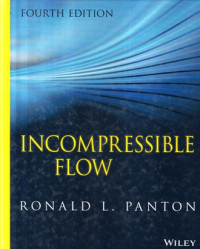Text
Incompressible flow
The fourth edition of Incompressible Flow has several substantial revisions. Students now have ready access to mathematical computer programs that have advanced features and are easy to use. This has allowed inclusion, in the text and the homework, of several more exact solutions of the Navier-Stokes equations. Additionally, more homework problems have been added that rely on computation and graphical presentation of results. The classic-style Fortran programs for the Hiemenz flow, the Psi-Omega method for entrance flow, and the laminar boundary layer program have been revised into Matlab . They are also available on the web. The Psi-Omega finite-difference method is retained for historical reasons; however, a discussion of the global vorticity boundary restriction is introduced. Examples of the ring line vortex and the Fraenkel-Norbury vortex solutions have been added to a revised vorticity dynamics chapter. Another example is the "dual" solution to the Hiemenz stagnation point flow. This is a second solution of the Navier-Stokes equations with Hiemenz boundary conditions and is now a reasonable homework assignment. The compressible flow chapter, which used to emphasize heating by viscous dissipation and unsteady wave propagation, now includes a discussion of the different behaviors that occur in subsonic and supersonic steady flows. Some additional emphasis has been given to composite asymptotic expansions. They are initially presented in the solutions of the Navier-Stokes chapter with the viscous coupling problem. Further discussion in asymptotic analysis methods chapter includes their use in correlating data from experiments or direct numerical simulations. Although Hele-Shaw flows are at low Reynolds numbers, and could have been placed in that chapter, the new presentation has been placed in the lubrication approximation chapter. Electrostatic and electrodynamic effects are important in many microflows. These subjects were not treated for two reasons. To do so with sufficient rigor would require considerable space, and there are several new books devoted exclusively to Microflows that fill this need. The turbulence chapter has been extensively reorganized placing wall turbulence ahead of free-shear layers. DNS results have supplemented new experimental information and improved our understanding. New accurate mean flow data at higher Reynolds numbers now exists. The correlation of fluctuating velocities and vorticity profiles is a work in progress. The index is organized so that flow patterns can easily be referenced. Under the listing "Flow" secondary groups (viscous, inviscid, boundary layer, etc.) are given before the specific pattern is listed.
Ketersediaan
Informasi Detail
- Judul Seri
-
-
- No. Panggil
-
532 Pan i
- Penerbit
- New Jersey : Wiley., 2013
- Deskripsi Fisik
-
xx, 878 hal. : il. ; 25 cm.
- Bahasa
-
English
- ISBN/ISSN
-
9781118013434
- Klasifikasi
-
532
- Tipe Isi
-
-
- Tipe Media
-
-
- Tipe Pembawa
-
-
- Edisi
-
Ed. IV
- Subjek
- Info Detail Spesifik
-
-
- Pernyataan Tanggungjawab
-
-
Versi lain/terkait
Tidak tersedia versi lain
Lampiran Berkas
Komentar
Anda harus masuk sebelum memberikan komentar

 Karya Umum
Karya Umum  Filsafat
Filsafat  Agama
Agama  Ilmu-ilmu Sosial
Ilmu-ilmu Sosial  Bahasa
Bahasa  Ilmu-ilmu Murni
Ilmu-ilmu Murni  Ilmu-ilmu Terapan
Ilmu-ilmu Terapan  Kesenian, Hiburan, dan Olahraga
Kesenian, Hiburan, dan Olahraga  Kesusastraan
Kesusastraan  Geografi dan Sejarah
Geografi dan Sejarah